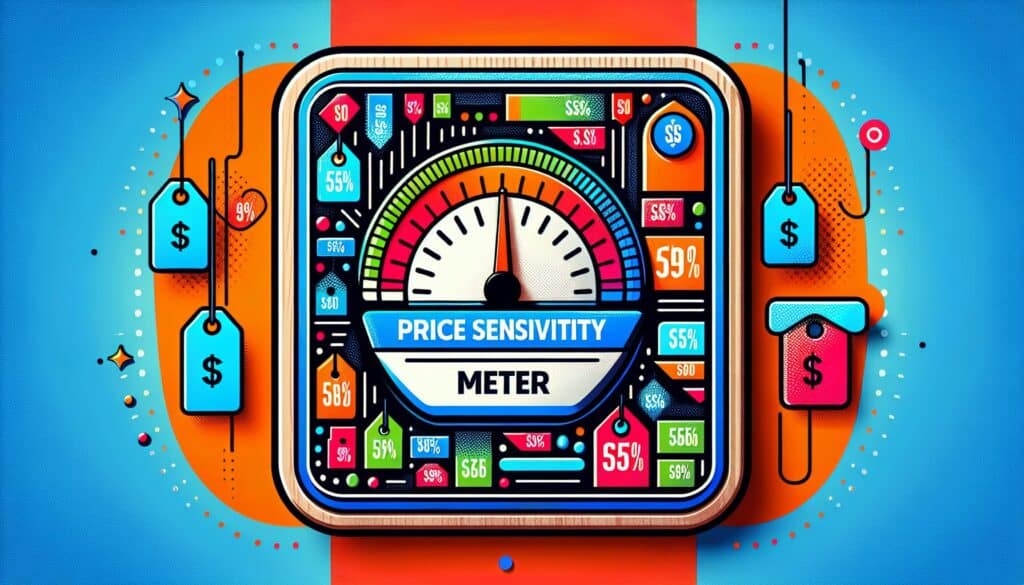Identificar una gama de precios psicológicamente aceptables para un producto planteando a los consumidores cuatro preguntas específicas relacionadas con el precio.
- Metodologías: Clientes y marketing, Economía
Medidor de sensibilidad al precio Van Westendorp (PSM)

Medidor de sensibilidad al precio Van Westendorp (PSM)
- Análisis competitivo, Experiencia del consumidor, Trayectoria del cliente, Estudios de mercado, Desarrollo de productos, Gestión de productos, Precios de los productos, Propuesta de valor
Objetivo:
Cómo se utiliza:
- Se pregunta a los encuestados en qué punto de precio estaría el producto: 1) tan barato que dudarían de su calidad, 2) una ganga, 3) empezando a ser caro y 4) demasiado caro para tenerlo en cuenta. Las intersecciones de las respuestas indican un punto de precio óptimo y un rango de precio aceptable.
Ventajas
- Ofrece una gama de precios aceptables, fácil de entender y aplicar, ayuda a identificar los umbrales de precios.
Contras
- No mide directamente la intención de compra a precios específicos, los resultados pueden verse influidos por la familiaridad y el contexto del encuestado, no tiene en cuenta los precios de la competencia.
Categorías:
- Clientes y marketing, Economía
Ideal para:
- Comprender las percepciones de precios de los consumidores e identificar una gama de precios aceptable para un producto nuevo o existente.
El Medidor de Sensibilidad al Precio (PSM) de Van Westendorp es especialmente eficaz durante las primeras fases de desarrollo de un producto, sobre todo en sectores en los que las estrategias de fijación de precios influyen significativamente en el éxito de mercado, como la electrónica de consumo, la moda y los productos alimentarios. Esta metodología puede ser iniciada por equipos de investigación de mercado o jefes de producto que buscan comprender la dinámica de precios en relación con las expectativas del consumidor. A menudo complementa otras estrategias de fijación de precios, como la técnica de Gabor-Granger, en la que se pueden obtener datos más cuantitativos a partir de preguntas sobre la disposición a pagar que implican escenarios de compra reales. El PSM facilita una exploración cualitativa de las actitudes de los consumidores hacia el precio, lo que permite a diseñadores e ingenieros posicionar sus productos con eficacia. Por ejemplo, en la industria automovilística, la aplicación del PSM durante la fase conceptual puede ayudar a evaluar cómo perciben los consumidores el precio de los nuevos vehículos eléctricos en relación con las opciones tradicionales, lo que puede ser fundamental para la aceptación del mercado. La naturaleza interactiva del PSM permite el compromiso con diversos segmentos de consumidores, garantizando que los datos resultantes reflejen una amplia gama de aceptación de precios, lo que resulta especialmente valioso en industrias sujetas a cambios rápidos o a una fuerte competencia. A menudo se recomienda la colaboración entre los equipos de marketing, ventas y desarrollo de productos, lo que puede conducir a una toma de decisiones más informada y a la alineación de estrategias de precios que satisfagan tanto la demanda del mercado como los objetivos financieros. Además, el uso de la GSP puede revelar matices en la psicología del consumidor, lo que sirve de base para las estrategias de marca y la comunicación en torno al precio, que son esenciales cuando se lanzan productos de primera calidad.
Pasos clave de esta metodología
- Pida a los encuestados que indiquen el precio más bajo al que dudarían de la calidad del producto.
- Solicite el precio que consideraría una ganga para el producto.
- Preguntar el punto de precio que creen que se está encareciendo.
- Determine el precio al que el producto sería demasiado caro para tenerlo en cuenta.
- Analice las intersecciones de los puntos de precio para identificar un precio óptimo y un rango aceptable.
Consejos profesionales
- Recopilar información cualitativa junto con los datos de la GSP para comprender la lógica que subyace a la percepción de los precios y los umbrales.
- Realizar un análisis de seguimiento para examinar cómo influyen los factores externos, como los competidores y las tendencias del mercado, en la sensibilidad a los precios y el comportamiento de los consumidores.
- Realizar pruebas iterativas ajustando los puntos de precio tras los resultados iniciales de la PSM para perfeccionar las estrategias de precios basándose en las respuestas de los consumidores en el mundo real.
Leer y comparar varias metodologías, recomendamos el
> Amplio repositorio de metodologías <
junto con otras más de 400 metodologías.
Sus comentarios sobre esta metodología o información adicional son bienvenidos en la dirección sección de comentarios ↓ , así como cualquier idea o enlace relacionado con la ingeniería.
Contexto histórico
1960
1980
1983
1990
1995
2000
2010
1950
1980
1980
1986
1994
1995
2000
(si se desconoce la fecha o no es relevante, por ejemplo "mecánica de fluidos", se ofrece una estimación redondeada de su notable aparición)














Publicaciones relacionadas
Gestión de operaciones de fabricación (MOM)
Sistema de Ejecución de Fabricación (MES)
Plan de control de la fabricación
Pruebas manuales
Tablas de evaluación de la manipulación manual (MAC)
ManTRA (Herramienta de evaluación de riesgos en las tareas manuales)